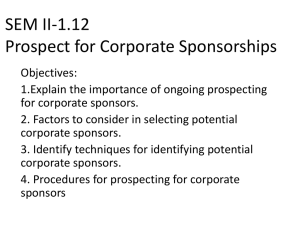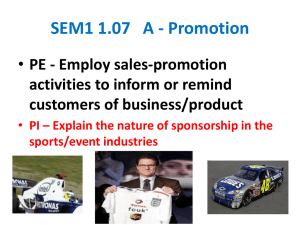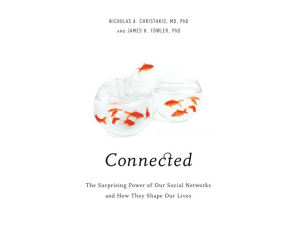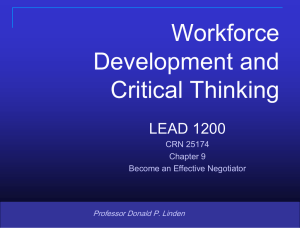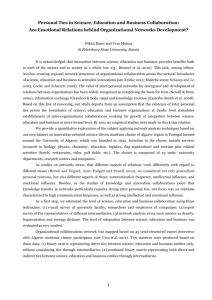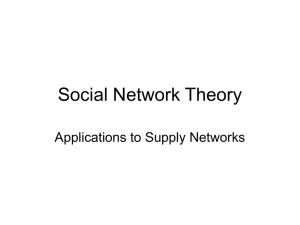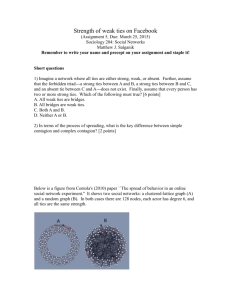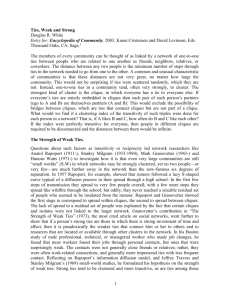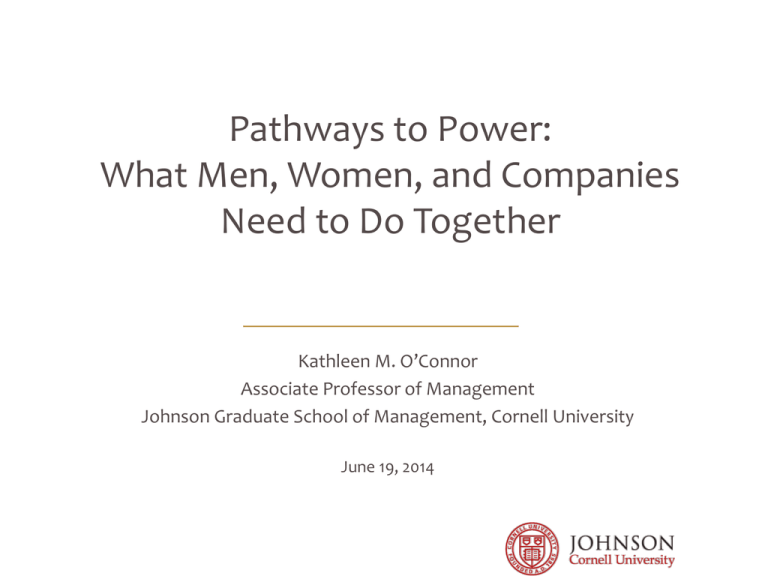
Pathways to Power:
What Men, Women, and Companies
Need to Do Together
Kathleen M. O’Connor
Associate Professor of Management
Johnson Graduate School of Management, Cornell University
June 19, 2014
What’s The Problem?
5.0%
8.1%
16.9%
CEOs
Top Earners
Board Seats
14.6%
51.4%
46.8%
Executive Officers
Management,
Professional, and Related
Occupations
U.S. Labor Force
Women in Business
* Catalyst Research (2013) and Bureau of Labor Statistics, Current Population Survey,
“Table 18: Employed Persons by detailed industry, sex, race, and Hispanic or Latino
ethnicity, 2012” (2013)
What’s The Problem?
0%
12.4%
CEOs
Board Directors
14.6%
78.4%
Women in Health Care
Executive Officers
Industry Labor Force
What’s The Problem?
1.3% CEOs
17.9% Board Directors
17.6%
Executive Officers
55.7%
Women in Finance and Insurance
Industry Labor Force
Second-Generation Bias*
• Paucity of role models for women
• Gendered career paths and gendered work
• Double binds
• Women’s lack of access to networks and sponsors
* Ibarra, Ely & Kolb, 2013. Women rising: The unseen barriers. HBR.
Roadmap
• Identify effective pathways to power.
• Highlight what we know can work for women to make us
more powerful and more helpful to other women seeking
power and success.
• Take away concrete tactics for building and leveraging
power.
Pathways to Power
• Gaining Sponsorship
• Developing an Effective Network
• Negotiating Resources
Gaining Sponsorship
Is Mentorship Helping Women?
2008 Catalyst survey of 4000 men and women from top MBA programs
(1996-2007)
• Women occupying lower-level mgt positions and receiving lower pay
• Women reported lower career satisfaction
• A follow-up survey showed that men were 15% more likely to have been
promoted, but had had the same number of lateral moves as women
• Men were receiving promotions after the lateral move, and women were
getting lateral moves in lieu of promotion
• Women were more likely to report having a mentor
Maybe being mentored is the problem
• Mentorship—giving feedback, advice
• Sponsorship—using influence with senior execs to advocate for mentee
A sponsor is
someone who:
Uses chips
on my
behalf
Advocates
for my next
promotion
and does at
least two of the
following:
Expands my
perception of
what I can do
Gives career
advice
Makes
connections
outside the
company
Makes
connections to
senior leaders
Promotes my
visibility
Connects me
to career
opportunities
Advises me on
my appearance
The Sponsorship Effect
Both women and men who are sponsored
• are relatively more satisfied with their rates of
advancement
• are relatively more likely to ask a manager for a stretch
assignment
• are relatively more likely to ask a manager for a pay raise
Backing is a springboard
What Sponsors do for Proteges
Benefits of Sponsoring
71%
61%
47%
40%
34%
30%
Gains for me when
protégé goes "extra
mile"
Looking good when Satisfaction in "paying
protégé is successful
it forward"
Women
Men
How To Gain Sponsorship
Find a Sponsor
• Pick The Right Ones
• Look Inside, Look Outside
• Take Charge
Earn Sponsorship
• Get Results
• Get Noticed
• Build Rapport
• Broaden Your Scope
• Give More Than You Get
Developing an Effective
Network
Features of Useful Networks
• Diversity in membership
– Levels, functions, experience, industry, sex, race
• The strength of weak ties
– Deep, trusting relationships (strong ties) help
provide social support and with facilitating
sensitive information exchange
– Acquaintances (weak ties) help
access unique information
• Mind the gap
– Structural holes gives you power
* Burt, 1996
Figure depicts the networks of two people—Robert and James
The structural hole between clusters A and C enable Robert to broker
this space, as well as act as a conduit between C and B
Key Features of Effective Networks
Recap: Key Features of Effective
Networks
• Weak ties and structural holes enable you to have valuable contacts to
people (other functions, at higher levels)
• These contacts provide you with
– Access to information
– Access to resources
– Access to career sponsorship
• All three positively determine promotions and career satisfaction, but
career sponsorship directly determines salary
Women’s Networks
• Because ‘birds of a feather flock together,’ women’s
networks have more women, and men’s have more men
• Because men are more likely to hold powerful positions
• women have a smaller pool of high-status, same gender contacts
on which to draw, and
• women have fewer ties to powerful, high-status men
Consequently,
• women’s networks tend to
• yield fewer leadership opportunities,
• provide less visibility for their leadership claims, and
• generate less recognition and endorsement
Successful Women’s
Network Strategies
Comparisons of high-potential women and other women
(Ibarra, 1997)
– Hi-po women (formally designated) had more heterogeneous
ties when compared to high-potential men and low-potential
women. They had a larger set of both strong and weak ties,
and more ties to both men and women.
– Women were promoted earlier when they included highly
placed men who were not their bosses in their networks
(sponsors), and when their networks included people both
within and outside their workgroups.
Consider Your Network
• How powerful are the people in your network?
• Do you have a sponsor?
• To what extent are you connected to people who are
members of different groups?
• What is your strategy for developing contacts in other
functions, at different levels?
• How will you maintain the weak ties in your network?
Building an Effective Network
• Develop a personal ‘board of directors’ that includes
mentors, sponsors, and friends.
• Because people like to provide information, ASK.
• Focus on the give.
• Reactivate dormant ties. Send an article, offer useful
information, ask a favor, congratulate.
• Develop homophilous & heterogeneous ties.
Negotiating Resources
Women’s Entitlement Problem
• Men & women participated in a task evaluating applications of
incoming freshmen and were asked to evaluate their likely success.
They paid themselves what they thought was fair for their labor.
Men paid themselves 63% more than women.
• Men & women were given $4 and asked to count dots in a series of
pictures. They were told to keep working until they had earned the
$4. Women worked 22% longer than men, and counted 32% more of
the dots. Even though women worked longer & faster, the men and
women were equally satisfied with their pay.
• How often do you just accept what you are offered?
Eliminating the Entitlement Problem
• …In a follow-up to the “pay yourself” study - when
participants saw a list of the rates that previous
participants had paid themselves, the gender pay
differential disappeared.
• When clear information is available – gender differences
tend to be much smaller, or even disappear. But for
more ambiguous issues the gap can still be very large.
• Answer? Get information! (How? Through mentors,
sponsors, and other network connections)
Getting What You Deserve
Women tend to work hard and hope that their work alone
will earn them the recognition and rewards they deserve
(tiara syndrome).
• Do you have the information you need to put all the
issues on the table and know what is possible?
• Are you comparing yourself to the right people?
• Do you have a sponsor who helps you set goals, gain
visibility, develop your talent and skills, and advocates
for you to help you get what you deserve?
The Negotiation Sweet Spot
Economic
Reputational
Relational
28
What Matters?
•
•
•
•
•
•
Smart?
Extraverted?
Confident?
Attractive?
Prepared?
Inventive?
29
Economic
Traits
Positive affect
Negative affect
Extraversion
Conscientiousness
Agreeableness
Neuroticism
Openness to experience
Machiavellianism
Self-esteem
Positive Expectations
Confidence (tough)
Confidence (collaborative)
Ability
GMAT
Emotional Intelligence
Creativity
.17 *
-.04
.13
.01
.02
.02
-.08
.09
.11
.18 *
.21 **
-.10
.06
.05
Motivation
Concern for own outcomes
.21 **
Concern for others’ outcomes -.03
Ethicality
.03
Visible Characteristics
Female
Physical attractiveness
Elfenbein, Curhan, Eisenkraft, Shirako ,Baccaro (2008)
-.01
-.07
30
Economic
Powerful
drivers of how
well one does
(economic
ally) are not
fixed and out
of our control.
Rather, they
are mutable,
with
confidence
topping the
list.
Traits
Positive affect
Negative affect
Extraversion
Conscientiousness
Agreeableness
Neuroticism
Openness to experience
Machiavellianism
Self-esteem
Positive Expectations
Confidence (tough)
Confidence (collaborative)
Ability
GMAT
Emotional Intelligence
Creativity
.17 *
-.04
.13
.01
.02
.02
-.08
.09
.11
.18 *
.21 **
-.10
.06
.05
Motivation
Concern for own outcomes
.21 **
Concern for others’ outcomes -.03
Ethicality
.03
Visible Characteristics
Female
Physical attractiveness
-.01
-.07
31
Tactics for Better Negotiated
Outcomes
• Separate interests from positions
• Hear the other side
• Invest in the relationship
• Focus on your goals
• Think creatively
Separate Interests from Positions
• What you really want and care about? Your interests.
• What you demand, offer, and reject? Your positions.
• Get beyond positions to discover what the other side really
wants/cares about
– Ask questions
– Give a little to kickstart reciprocity
Hear the Other Side
• Asking questions is important, but you must listen to the
answers they provide
–
–
–
–
–
Why do you need that?
What do you like about the offer?
What absolutely will not work?
What do you need to make this deal work?
What could I give you to make this deal work?
Invest in the Relationship
• To elicit information
– Build rapport
– Encourage trust
– Listen to answers
Yes, fine, but HOW?
Strategy of interest-based
bargaining
To learn about interests, must
gain trust, access information,
use information wisely
How to gain trust to access
information?
• Schmooze to build rapport
• Mirroring
36
Build rapport through schmooze
Rapport
6
5
4
No Schmooze
3
Schmooze
2
1
0
No Schmooze
Morris, Nadler, Kurtzberg, & Thompson, 2002
Schmooze
* Have a 5-min get-to-know-you conversation
37
Mirroring delivers gains
Joint Profits
12600
12400
12200
12000
Party Matched
Party did not Match
11800
11600
11400
11200
Party Matched
Party did not Match
Maddux, Mullen, Galinsky, 2008
38
The Payoff
The more the other side likes, trusts,
and respects you, the more
information the other side will share
with you.
Greenhalgh & Chapman, 1998
39
Frame the Negotiation
• Anticipating a negotiation can be stressful (O’Connor &
Arnold, 2011).
• Describing a problem solving situation as a negotiation
versus a chance to solve a problem shapes the interaction
and affects outcomes (O’Connor & Adams, 1997).
– Relative to those in the problem solving condition, those in the
negotiation condition:
•
•
•
•
Cared less about helping the other side achieve his/her goals
Did not expect to like the other person as much
Had a less accurate understanding of the other side’s priorities
Did worse
Think Creatively
• A key to getting the other side to accept is to consider
“what’s in it for them.”
• The more issues there are, the more possibilities there can
be to give them what they want (at low cost to you),
allowing you to strike a mutually acceptable deal.
• Does creativity matter?
– YES. Having just one highly creative individual in the negotiating
pair is sufficient for both sides to do well (by making profitable
trades between issues) (Kurtzberg, 2010).
Recap Negotiation
• Negotiation is a set of skills you need to hone to get access
to resources for yourself, your reports, your unit.
• Willingness to initiate a negotiation is half the battle.
• Prepare by getting information through your network.
• Sharpen your skills to get what you are entitled to.
Pathways to Power
• Gaining Sponsorship
• Developing an Effective Network
• Negotiating Resources
Putting it Together
• Identify sponsors who will provide you with information,
opportunity and advocacy.
• Build effective networks by
• Reconnecting with dormant ties,
• Finding ways to bridge people at the edges of structural holes,
• Cultivating weak ties.
• Rely on your networks to negotiate.
• Negotiate.
The Last Word(s)
Developing and exploiting pathways to power require:
• Persistence
• Ask early and often. You will be told no, but sometimes you will be told
yes. Play the odds (men have known this for centuries)
• Focus
• Be deliberate and thoughtful about identifying potential sponsors and
network connections
• Time
• Dig your well before you’re thirsty. It will take time to build and exploit
new pathways


